DAUGHTER ZION

Sing aloud, O daughter of Zion; shout, O Israel!
Rejoice and exult with all your heart,
O daughter of Jerusalem!
The Lord has taken away the judgments against you;
he has cleared away your enemies.
The King of Israel, the Lord, is in your midst;
you shall never again fear evil.
On that day, it shall be said to Jerusalem:
“Fear not, O Zion; let not your hands grow weak.
The Lord your God is in your midst,
a mighty one who will save;
he will rejoice over you with gladness;
he will quiet you by his love;
he will exult over you with loud singing.
Zephaniah 3, 14-18
And Mary said,
“My soul proclaims the greatness of the Lord,
my spirit rejoices in God my saviour,”
for he has looked with favour on his lowly handmaid.
From henceforth, all generations will call me blessed;
for He who is mighty has done great things for me,
and holy is His name.”
Luke 1, 46-49
The Hebrew name “Tzion” (ציון), translated as “Zion,” appears over 150 times in the Bible. These references include “Zion,” “Mount Zion,” “the daughter of Zion,” and “the virgin daughter of Zion.” The first mention of Zion occurs in 2 Samuel 5:7: “David captured the fortress of Zion, which is the City of David.” Originally, Zion was an ancient Jebusite fortress that David captured, allowing the Israelites to take possession of Jerusalem. Over time, the royal palace and the temple were built there, and Zion, or Jerusalem, became the seat of power in the kingdom of Israel (Judah after the schism) and the chief site of worship. Consequently, Zion is referred to as “the City of David” and “the City of God.” The term also metaphorically extends to the Temple (Synagogue) and represents God’s kingdom on earth.
The name “Zion” means “fortification” and conveys the idea of being “raised up” as a monument and a sign of God’s presence among the Israelites, as well as His reign on earth. As a fortress, Zion provided refuge and protection for the Israelites from their enemies. Located on a hill on the southeast side of Jerusalem, it was the strongest and safest place in the city for its inhabitants, who took shelter there. Throughout history, from the time of David and during the reign of the righteous Davidic kings, this fortress, established by God’s providential design, remained inviolable, with no enemy ever breaching its walls.

From a spiritual perspective, God protects His innocent daughter from the rape that her enemies intend to commit against her. He keeps her pure and shielded from the gross idolatry that corrupts the surrounding pagan nations, which is akin to spiritual unfaithfulness. God has removed His chosen people from their original corruption in the world and has consecrated them as His own through a covenant, which He will faithfully uphold despite their occasional unfaithfulness. This covenant with His chosen people is everlasting. However, with their transgressions against His laws and commandments comes divine punishment, as warned.
Nevertheless, on Mount Zion, the faithful remnant of Israel will never be conquered or destroyed by their enemies, thanks to God’s gracious protection. Zion is a significant place where the word of God resides and is revealed. As stated in Isaiah 2:3, “For out of Zion shall the Torah come forth, and the word of the Lord from Jerusalem.” The temple is the dwelling place of God, from which His word is proclaimed and His laws are given. Those who hear and follow the word of God are likened to Mount Zion, which will never be shaken (Ps 151:1). Additionally, the name Zion represents God’s chosen people and faithful servants, from whom the promised Messiah will arise to rule all nations with righteousness and justice, wielding a rod of iron (Ps 2:9; Rev. 2:27; 12:5; 19:15).

In Mary’s Canticle of Praise, commonly referred to as the Magnificat, it becomes clear that the first Jewish converts to Christianity during the Apostolic era viewed Mary not merely as a symbolic figure but as the living embodiment of Daughter Zion. For these early believers, Mary represented far more than an abstract concept or a collective identity; she was the mother of Jesus, their Lord, as expressed in Luke 1:43, and served as the physical manifestation of the Woman of Promise, through whom the Divine Child was born, fulfilling the prophecy found in Galatians 4:4.
This profound understanding enabled early Christians to form a deeply personal connection with Mary, much like the one they shared with her son, Jesus. They recognized her not only as a pivotal figure within the narrative of salvation but also as an individual who embodied grace, humility, and obedience to God’s will. The early Church’s reverence for Mary was underscored by her active participation in the redemptive process as highlighted in Luke 1:45, where her faith and acceptance of God’s plan were celebrated.

Furthermore, the belief in her Assumption into Heaven, body and soul, reinforced her significance among the faithful. This doctrine, which acknowledges Mary’s unique role and sanctity, allowed the early Christians to view her as a compassionate intercessor who could advocate for them before her Son. In essence, they saw Mary as someone they could not only love and venerate but also as a relatable figure who understood their struggles and hopes, thus deepening their spiritual connection to the mystery of the Incarnation and the promise of salvation.
The parallel that Luke draws between Mary and Daughter Zion is profoundly significant, as it resonates with the rich tapestry of Old Testament prophecies and offers allusions to revered Psalms. This connection highlights that the Marian tradition within the early Church in Palestine was not merely an isolated belief but rather a dynamic element of the faith, deeply rooted in Jewish heritage. In the initial segment of the Magnificat, Mary articulates her relationship with God, highlighting her exalted status in the divine order of grace. Importantly, all four verses found in Luke 1:46-49 closely reflect the themes and imagery found in Old Testament passages that celebrate Daughter Zion, further reinforcing Mary’s integral role within this ancient narrative. This intertextuality not only enriches our understanding of Mary’s significance but also illustrates the continuity between the Jewish faith and emerging Christian beliefs.
And Mary said,
“My soul proclaims the greatness of the Lord,
My spirit rejoices in God, my savior,
I will rejoice greatly in the Lord;
my soul shall exult in my God;
for he has clothed me with the garments of salvation,
he has covered me with the robes of righteousness.
– Isaiah 61, 10 (cf. Zech. 9:9; Zeph. 3:14)
“for he has looked with favor on his lowly handmaid.
The Lord has taken away the judgments against you,
he has cast out your enemies.
The King of Israel, the Lord, is in your midst;
you shall fear evil no more.
– Zephaniah 3, 15 (cf. Lk. 1:28, 30)
But you, O Lord, will arise and have compassion on Zion,
for it is time to show favour on her;
the appointed time has come.
– Psalm 102, 13
“From this day, all generations will call me blessed;
At that time, I will bring you home,
at the time when I will gather you together;
yea, I will make you renowned and praised
among all the peoples of the earth,
when I restore your fortunes
before your eyes, says the Lord.
– Zephaniah 3, 20
I will perpetuate your memory through all generations;
therefore, the nations will praise you for ever and ever.
– Psalm 45, 17
“because the Almighty has done great things for me,
and holy is his name.”
When the Lord restored the fortunes of Zion,
then we thought we were dreaming.
Our mouths were filled with laughter;
our tongues sang for joy.
Then it was said among the nations,
“The Lord has done great things for them.”
The Lord has done great things for us;
Oh, how happy we were.
– Psalm 126, 1-3

And it shall come to pass that everyone who calls on the name of the Lord
shall be saved. For in Mount Zion and in Jerusalem there shall be those
who escape, as the Lord has said, and among the survivors shall be those
whom the Lord calls.
Joel 2, 32.
During periods of foreign oppression, such as the Babylonian exile, the symbolism of Zion took on new meanings. The destruction of the Temple and the loss of sovereignty led to a longing for restoration and spiritual renewal. Prophetic literature reinforced the notion of Zion as a place of hope and future salvation, solidifying its importance in Jewish eschatology.
With the advent of Christianity, early Jewish followers of Jesus began reconceptualizing traditional beliefs in the light of Christ’s teachings and the fulfillment of the Hebrew Scriptures. The relationship between Mary and the concept of Daughter Zion emerged during a period of significant theological development. Early believers saw Mary’s role as central to God’s salvation plan, viewing her not just as a revered figure but as a living embodiment of the faithful remnant of Israel. This perspective aligned with the understanding of the Messiah’s lineage coming from Zion.
The Gospel of Luke reflects this shift, presenting Mary in ways that resonate with Old Testament motifs, particularly the imagery associated with Zion. The Magnificat expresses themes of divine favor and fulfillment, linking Mary to the broader narrative of restoration and hope for Israel. As the early Church formed, the belief in Mary’s Assumption and her intercessory role further solidified her significance, particularly as Christians faced persecution and sought figures of compassion and understanding in their faith journeys. Mary’s status as Daughter Zion symbolized a bridge between the Jewish faith and the emerging Christian identity, illustrating the continuity of God’s redemptive plan. Overall, the historical context reveals a dynamic interplay between the Jewish heritage of Zion and the burgeoning Christian understanding of Mary, shaping the theological foundations of both traditions and their interpretations over time.

For thus the LORD said to me, As a lion or a young lion growls
over its prey, and — when a band of shepherds is called out against it —
is not terrified by their shouting or daunted at their noise, so the LORD
of hosts will come down to fight upon Mount Zion and upon its hill.
Isaiah 31, 4
The passage from Isaiah 31:4 is situated in a historical context during the late 8th century BC, during the time of the Assyrian Empire’s expansion in the Near East. This period was marked by significant political turmoil for the Kingdom of Judah, as it faced threats from the mighty Assyrians, who had already conquered the northern kingdom of Israel in 722 BC. This passage uses the imagery of a lion to convey a powerful message about God’s protection and relentless pursuit of justice, particularly regarding His people, often referred to as “Daughter Zion.” In biblical literature, Daughter Zion is a personification of Jerusalem and, by extension, the people of Israel. This metaphor represents both vulnerability and strength, as Zion is seen as God’s chosen place, yet it faces threats and challenges.
When considering the Virgin Mary in relation to this text, she can be viewed through the lens of Daughter Zion. In Christian theology, Mary is often regarded as the embodiment of Israel’s hopes, a vessel through which salvation enters the world. Just as God stands firm to protect Zion, the narrative of Mary reflects God’s faithfulness and involvement in human history, emphasizing that, despite the dangers surrounding her, she plays a crucial role in God’s redemptive plan. Additionally, Mary’s acceptance of God’s message and her strength in the face of challenging circumstances mirror the steadfastness of Zion. She exemplifies faith and obedience, demonstrating that God’s purpose prevails even amid chaos, much like the lion that remains unafraid, regardless of the circumstances.
Ultimately, this passage can be understood as a proclamation of divine assurance, echoing through both Daughter Zion and the Virgin Mary. It reassures believers that God’s protective presence is constant, offering hope and serving as a reminder of the salvation that comes through unwavering faith.

Sing and rejoice, O daughter Zion!
For lo, I will come and dwell in your midst,
says the LORD.
Zechariah 2, 10
The text from Zechariah 2:10, “Sing and rejoice, O daughter Zion! For lo, I will come and dwell in your midst, says the LORD,” speaks to a time of restoration and hope for the people of Israel. To understand its significance, we must explore the historical context in which Zechariah prophesied, as well as the broader implications associated with “daughter Zion” and its connection to the Virgin Mary.
Zechariah was a prophet during the post-exilic period of Israel’s history, a time when the Jewish people were returning from Babylonian captivity and seeking to rebuild their lives and their sacred temple in Jerusalem. The prophets of this era, including Zechariah, played a crucial role in encouraging the people to restore their faith and renew their covenant with God. This message of joy and the promise of God’s presence served to uplift a community that had faced significant despair and loss.
The phrase “daughter Zion” metaphorically represents Jerusalem or the people of Jerusalem, often personified as a female figure. In this context, it reflects the city’s deep spiritual connection to God, who promises to return to dwell among His people. This promise acts as a reassurance that, despite their trials, God would once again establish His presence in their midst, providing comfort and hope for future restoration.

“Daughter Zion” embodies the identity and collective spirit of the Israelites, signifying their unique relationship with God. In biblical texts, Zion is not just a physical location; it represents the heart of Israel’s spiritual life. By addressing Zion as “daughter,” the text emphasizes tenderness, care, and a sense of belonging. The call to “sing and rejoice” compels the people to respond with joy at the assurance that God’s presence will shield and restore them. In the context of Christian theology, “Daughter Zion” is often interpreted as a prophetic foreshadowing of the Virgin Mary. Just as Zechariah speaks of God’s promise to dwell among His people, Christians believe that this was ultimately fulfilled in Jesus Christ, who is seen as God incarnate. Mary, as the mother of Jesus, holds a specific place in this narrative.
Just as God promised to dwell among His people in Zechariah, Mary became the sacred vessel through which God incarnate—Jesus—entered the world, making her a vital figure in the manifestation of God’s presence. Mary’s response to the angel Gabriel (Luke 1:46-55), known as the Magnificat, mirrors Zechariah’s call to rejoice. It highlights her acceptance and joy in being a part of God’s divine plan. By interpreting Mary in relation to “daughter Zion,” Christian theologians often see her as the embodiment of the ideals of hope and fulfillment of God’s promise to His people—a theme central to both the Old Testament and the New Testament narratives. This connection deepens our understanding of God’s ongoing relationship with His people and His ultimate promise of redemption through Jesus.

O that deliverance for Israel would come from Zion!
When God restores the fortunes of his people,
Jacob will rejoice; Israel will be glad.
Psalm 53, 6
Psalm 53:6 expresses a deep longing for deliverance and restoration for the people of Israel. To understand it in its historical context, particularly in relation to “Daughter Zion” and the Virgin Mary, we can examine a few key themes. First, the psalm reflects a period when Israel faced oppression and exile. The mention of Zion signifies the city of Jerusalem, which was seen as the dwelling place of God and a symbol of hope for the Jewish people. The call for deliverance from Zion speaks to the desire for divine intervention to restore the nation.
The longing for God to restore the fortunes of His people is rooted in the covenant between God and Israel. Throughout the Hebrew Scriptures, Zion represents not just a geographical location but also the spiritual heart of Israel, where God’s promises could be fulfilled. The psalm captures the essence of this relationship and the hope for a future where that covenant is realized.
In biblical literature, Zion is often personified as “Daughter Zion.” This imagery evokes a sense of intimacy and vulnerability, portraying the city as a female figure in distress, awaiting salvation. The call for deliverance encapsulated in Psalm 53:6 can be seen as a plea from Daughter Zion for God’s intervention, paralleling the communal cry of the people for restoration and joy. In Jewish tradition, Daughter Zion is deeply intertwined with messianic expectations. The restoration expressed in the psalm underscores the anticipation of a future Messiah who would bring peace and justice. This expectation eventually ties into Christian beliefs about Jesus, who is viewed as the fulfillment of these hopes.
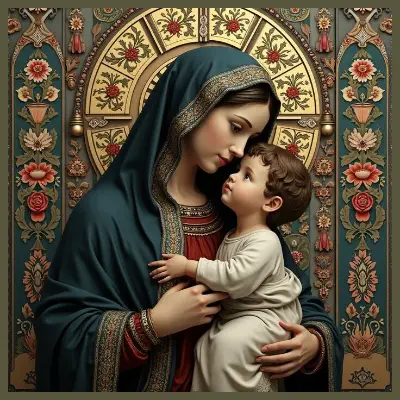
In Christian theology, Mary is often viewed as a new representation of the Daughter of Zion. Just as the original Zion was a site of God’s presence and hope, Mary, by bearing Jesus, embodies the fulfillment of the Old Testament prophecies regarding the Messiah. Her role as the mother of Christ situates her within the narrative of restoration and joy for Israel. The announcement of Jesus’ birth (often called the “Magnificat”) captures similar themes of rejoicing and deliverance. Mary’s song reflects a deep awareness of God’s mercy and faithfulness, paralleling the sentiments of Psalm 53:6. Her declaration that “all generations will call me blessed” resonates with the hope that the Psalm anagogically expresses for her future joy and restoration.
In essence, Psalm 53:6 can be seen as a powerful expression of the communal yearning for redemption that spans history, from the ancient people of Israel, through the portrayal of Daughter Zion, to the Christian narrative with the Virgin Mary. Each context amplifies the theme of divine deliverance, continuity of faith, and the ultimate joy that comes from God’s restoration of His people. This layered understanding underscores the interconnectedness of biblical themes and figures across both testaments.
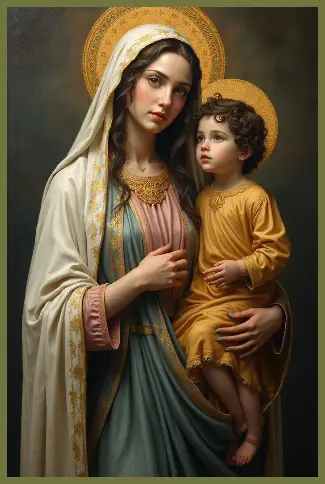
The LORD is exalted, he dwells on high;
he filled Zion with justice and righteousness.
Isaiah 33, 5
Isaiah prophesied during the 8th century BCE, a time marked by political instability, threats from neighboring empires, and moral decay within society. The Assyrian Empire was advancing and threatening the smaller kingdoms of Israel and Judah. The people of Judah faced the challenge of maintaining their identity and faith in God amid such external pressures and internal corruption. In this context, the phrase “The LORD is exalted, he dwells on high” emphasizes the sovereignty and transcendence of God—He remains supreme and is unaffected by human circumstances. This declaration reassures the people of Judah that despite their fears, God’s authority and power are above all, including the powerful Assyrian forces.
The mention of God filling Zion (Jerusalem) with “justice and righteousness” highlights the ideal characteristics that should define the community. Zion was seen not only as the physical dwelling place of God but also as a symbol of God’s covenantal relationship with His people. Justice and righteousness are central themes in the prophetic writings, reflecting the ethical standards God expects from His people, ensuring that the vulnerable are protected and that social injustices are addressed. Thus, this verse conveys a message of hope and a call to return to divine righteousness, reinforcing the idea that even in times of crisis, God’s presence can foster justice and righteousness within the community, urging the people to trust in His divine oversight and to align their lives according to His will.
When relating this verse to the concept of Daughter Zion and the Virgin Mary, we can draw several parallels. Daughter Zion often represents the personification of Jerusalem and, more broadly, the faithful community of believers. This imagery conveys a sense of hope, protection, and divine favor. In biblical poetry, Daughter Zion is sometimes portrayed as a woman who embodies the spirit of the city, expressing longing for God’s intervention and celebrating His justice and righteousness.
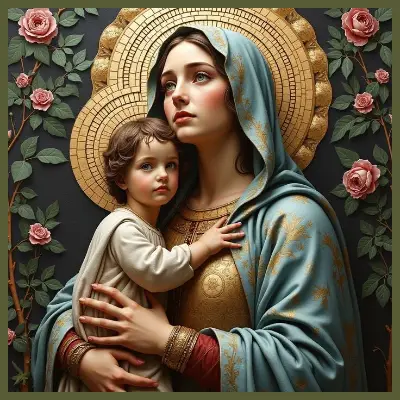
The Virgin Mary, as the mother of Jesus, is often seen as the ultimate fulfillment of the Daughter Zion archetype. Just as Daughter Zion represents the faithful waiting for the fulfillment of God’s promises, Mary embodies the actualization of that hope in her acceptance of God’s will and her role as the bearer of the Messiah. Mary’s humility, obedience, and righteousness make her a fitting representation of the qualities that the Lord fills in Zion.
Furthermore, just as Isaiah speaks of God’s justice and righteousness being present in Zion, Mary’s life and the way she raised Jesus demonstrate those very attributes. She embodies a profound trust in God’s plan and serves as an exemplary model of faithful discipleship. The exaltation of the Lord, therefore, can be seen in Mary’s exalted role in salvation history, as she brings forth the one who is the fulfillment of justice and righteousness for all humanity.
Isaiah 33:5 serves as a powerful reminder of God’s commitment to His people, represented through Daughter Zion and ultimately realized in the Virgin Mary. Both figures exemplify faithfulness to God’s promise, embodying justice and righteousness that bring hope and salvation.

Let Mount Zion be glad; let the towns of Judah
rejoice because of your judgments.
Psalm 48, 11
The verse “Let Mount Zion be glad, let the towns of Judah rejoice because of your judgments” from Psalm 48:11 is rich in historical and theological significance. Psalms, as a collection of lyrical poems and hymns, often express the relationship between God and His people, and this particular verse celebrates divine judgment and the security it brings to Jerusalem and the surrounding region. In its historical context, this Psalm likely came during a time when Judah faced external threats, perhaps from surrounding nations or empires. The reference to gladness and rejoicing emphasizes a triumphal theme, indicating that God’s judgments—understood as His decisions, actions, and decrees—are seen as positive for the people of Judah. They can rejoice because God’s righteous rule signifies both protection and deliverance.
Moreover, the Psalms often functioned as public prayers or songs used in worship, reflecting communal feelings of gratitude and celebration. The verse can be understood as an exhortation for the entire community to express joy for God’s justice and for the peace that follows His governance. In essence, it illustrates a deep trust in God’s leadership and a celebration of His sovereignty, particularly relevant during tumultuous periods in Judah’s history. The text from Psalm 48:11 emphasizes joy and celebration in Mount Zion and the towns of Judah due to God’s judgments. This sense of gladness is deeply rooted in the rich biblical tradition of Jerusalem as a holy city, representing God’s presence and favor among His people.

When exploring the connection between “Daughter Zion” and the Virgin Mary, it’s essential to understand that “Daughter Zion” often symbolizes the faithful people of Jerusalem, the congregation of Israel personified as a woman. In Christian theology, especially in the context of Mariology, Mary is sometimes referred to as the new “Daughter Zion.” The Virgin Mary embodies the fulfillment of the hope and promises of the Old Testament, as she is regarded as the mother of Jesus Christ, who is closely associated with the New Covenant. Just as “Daughter Zion” signifies the joy and celebration of a people redeemed by God’s justice, Mary also represents the joy of salvation coming into the world through her Son.
Thus, Psalm 48:11 can be viewed as a prefiguring of the joy that Mary brings to the world as the mother of the Messiah. Her acceptance of God’s will and her unique role in salvation history can be seen as a realization of the hope that “Daughter Zion” signifies—the joy and glory of God’s presence among His people, now manifested through Mary and her child, Jesus. In both interpretations, the joy of Mount Zion is echoed in the reverence and honor bestowed upon Mary, highlighting the continuity between the Jewish faith and Christian belief in God’s plan for salvation.

And all nations shall call you blessed:
for you shall be a delightful land,
says the LORD of hosts.
Malachi 3:12.
The verse from Malachi 3:12, “And all nations shall call you blessed: for you shall be a delightful land, says the LORD of hosts,” is situated within the context of post-exilic Judah. After the Babylonian exile, the Jewish community faced significant challenges in reestablishing its identity, worship, and societal order. Malachi, a prophet in this period, addresses these concerns and emphasizes the importance of faithfulness to God’s covenant. The message conveys hope and restoration, assuring the people that if they return to God and uphold their commitments, blessings will follow, not just for themselves but for the nations around them.
In the context of Daughter Zion, a biblical metaphor often used to represent Jerusalem or the people of Israel, the connection to the Virgin Mary arises within Christian theology. Daughter Zion symbolizes the idealized image of God’s chosen people. In the New Testament, Mary is viewed as the fulfillment of this image through her acceptance to bear Jesus Christ. Just as Daughter Zion is depicted as a place of divine favor and blessing, Mary is exalted for her role in providence, embodying the faithful and humble servant who plays a pivotal part in God’s redemptive plan.
The concept of “blessed” in Malachi resonates in the New Testament when Elizabeth refers to Mary as “blessed among women” (Luke 1:42), highlighting the continuity of the theme of favor from the Old Testament through to the New Testament. Both Daughter Zion and Mary represent hope, divine favor, and a pathway through which God’s blessings and promises are realized. In this light, Mary not only fulfills the prophetic imagery associated with Daughter Zion but also highlights the expansive nature of God’s promise, which encompasses all nations, echoing the call for a land blessed by divine presence.

Out of Zion, the perfection of beauty,
God has shined.
Psalm 50, 2
The verse “Out of Zion, the perfection of beauty, God has shone” (Psalm 50:2) holds rich significance in both its historical context and its theological implications, particularly in relation to the concepts of Daughter Zion and the Blessed Virgin Mary.
Psalm 50 is one of the Psalms attributed to Asaph and is considered a liturgical text addressing issues of worship and the proper conduct of Israel before God. In this Psalm, God calls upon His people to recognize their shortcomings and the importance of genuine faith over ritualistic worship. The mention of Zion is crucial, as it represents the city of Jerusalem, the location of the Temple, and the dwelling place of God among His people. In the ancient Israelite mindset, Zion was viewed as the epitome of God’s presence and majesty, symbolizing the beauty and holiness of divine governance. In the context of the Old Testament, Zion also embodies the hopes and promises of God to His people, acting as a symbol of redemption, restoration, and the establishment of God’s kingdom. The beauty referred to in the verse encompasses not only the physical aspects of Zion but also its spiritual significance as a place of divine revelation.
The term “Daughter Zion” is a biblical metaphor that personifies Jerusalem as a female figure, often expressing the deep emotional and spiritual relationship between God and His people. In texts such as Lamentations and Isaiah, Daughter Zion is depicted as mourning her desolation after experiencing judgment and exile. Yet, she also embodies hope and restoration as God promises to redeem her. This metaphor aligns with the spiritual understanding of Israel as a bride awaiting her bridegroom, further emphasizing the intimate covenant between God and His people. In this sense, Daughter Zion becomes a symbol of beauty, representing both the physical city of Jerusalem and the collective identity of the people of Israel, who are called to reflect God’s glory.

In Christian theology, particularly within the Catholic and Orthodox traditions, the Blessed Virgin Mary is often regarded as the ultimate embodiment of the Daughter of Zion. This connection stems from Mary’s role in the Incarnation of Christ. Just as Zion is seen as the dwelling place of God, Mary carried within her the Word-made flesh, which presents her as a living temple. The title “Daughter Zion” applied to Mary highlights her purity, obedience, and beauty as one chosen by God to bear the Messiah. In this sense, Mary fulfills the archetype of Zion, radiating divine beauty and grace. The Church views her as an exemplar of faith, contrasting with the unfaithfulness depicted in the Old Testament’s depictions of Daughter Zion.
Out of Zion, the perfection of beauty, God has shone. The verse “Out of Zion, the perfection of beauty, God has shone” from Psalm 50:2 emphasizes the idea of divine beauty and holiness emerging from a specific place, Zion, which is often associated with God’s dwelling and the location of His presence among His people. This concept can be beautifully tied to the doctrine of the Immaculate Conception of Mary. In the context of Mary’s Immaculate Conception, the idea of “perfection of beauty” can be understood as a metaphor for Mary herself. According to Catholic teaching, Mary was conceived without original sin, making her a pure vessel chosen to bear Jesus Christ, the ultimate expression of divine beauty. Just as Zion symbolizes the ideal place where God’s glory shines, Mary represents the pinnacle of creation, reflecting God’s grace and holiness.
The phrase “God has shone” can also be interpreted as an affirmation of how Mary serves as a source of light and grace in the world. Her purity and sinlessness not only embody the characteristics of beauty and holiness, but they also allow her to play a critical role in the salvation narrative. She becomes a bridge between God and humanity, mirroring the way Zion functioned as a central point for divine revelation. Thus, this text highlights both the perfection and beauty that God imparts, with Mary as a key participant in God’s plan, illustrating how God’s light shines through her to illuminate the way for all believers. In a spiritual sense, just as Zion represented a physical space of divine beauty, Mary signifies a unique and sacred person through whom divine grace is realized and made accessible to the world.
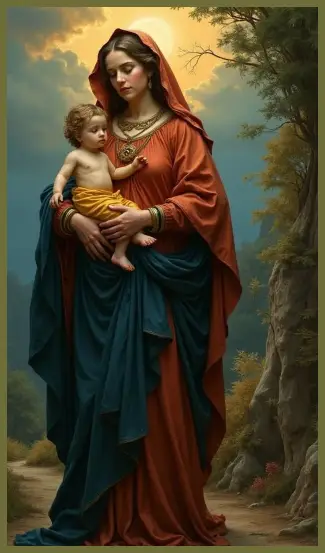
And you, O tower of the flock, hill of daughter Zion,
to you it shall come, the former dominion shall come,
the sovereignty of daughter Jerusalem.
Micah 4, 18
In Micah 4:8, “And you, O tower of the flock, hill of daughter Zion, to you it shall come, the former dominion shall come, the sovereignty of daughter Jerusalem,” there are several layers of meaning that can be connected to the figure of the Virgin Mary. The verse speaks of a coming restoration and sovereignty for Zion and Jerusalem, which can be linked to the role of Mary in salvation history. By bearing Jesus, who is often referred to as the King of Kings, Mary plays a crucial role in the fulfillment of the prophetic promise for a restored reign. Just as Zion is a symbol of God’s dwelling place and promise to His people, Mary embodies the hope and fulfillment of that promise through her divine motherhood.
In the historical context, “the tower of the flock” (Migdal Eder) refers to a specific location near Bethlehem where sheep were raised and sheltered. This imagery evokes a sense of pastoral leadership and the protection of the faithful. The “hill of daughter Zion” represents Jerusalem, the spiritual and political center of Israel. By promising that “the former dominion” and “the sovereignty of daughter Jerusalem” shall come, Micah reassures the Israelites that despite their current despair, God’s plan for restoration and sovereignty would ultimately prevail.

The phrase “O tower of the flock” can be interpreted in various ways. Traditionally, this refers to a watchtower where shepherds keep watch over their sheep. In the context of Mary, she can be seen as a protective figure for Jesus, the Good Shepherd, and subsequently for the flock, as members of the Church established by her Son on Peter, the Rock, and the Apostles. This connection is especially poignant given that the shepherds were the first to hear of Jesus’ birth through the angels, portraying Mary as central to the shepherds’ narrative of faith and expectation.
The term “daughter Zion” suggests a close relationship between the land and its people, with Mary representing the faithful response to God’s call. As a model of obedience, Mary embodies what it means to be a participant in God’s plan, echoing the virtues of the people of Jerusalem who await the Messiah. The “former dominion” that is foretold can also be viewed in light of Mary’s role in the establishment of God’s Kingdom through Christ. Mary’s acceptance of her role as the Mother of God exemplifies her participation in this sovereignty, highlighting her unique position as a pivotal figure in ushering in the reign of Christ.
The verse underscores the connection between the Old Testament prophecies and the New Testament fulfillment. Mary can be seen as the bridge between these covenants. Her life reflects the themes of hope, promise, and fulfillment that Micah speaks of, positioning her as a significant figure in God’s redemptive plan for humanity. In essence, connecting Micah 4:8 to the Virgin Mary reveals her integral role as a symbol of hope, obedience, and the fulfillment of God’s promises, highlighting her unique dignity as the mother of Christ and her importance in the narrative of salvation.
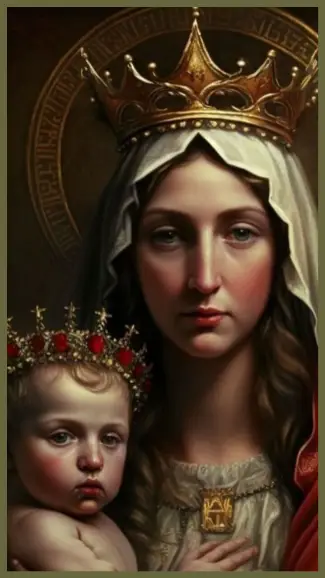
The LORD sends out from Zion your mighty sceptre.
Rule in the midst of your foes.
Psalm 110, 2
The verse from Psalm 110:2, “The LORD sends out from Zion your mighty sceptre. Rule in the midst of your foes,” plays a significant role in its historical and theological context. This Psalm is attributed to David and is often interpreted as a prophetic text concerning the reign of the Messiah.
In ancient Israel, Zion refers to both a specific geographical location—often seen as a symbol of Jerusalem—and a broader representation of God’s chosen people. The “mighty sceptre” signifies authority and power, emphasizing God’s sovereignty and the expectation of a ruler who would lead with strength. During David’s time, Israel was consolidating power and striving to establish itself against neighboring foes. Thus, the Psalm can be seen as both a celebration of David’s kingship and a foreshadowing of a future, ultimate ruler who would come from the line of David.
“Daughter Zion” is a personification of Jerusalem, often invoked in biblical poetry and prophetic literature. This image characterizes Jerusalem as a daughter awaiting salvation, comfort, and divine intervention. In the context of Psalm 110, we see the anticipated ruler (often understood to be the Messiah) bringing about justice and peace. This ties into the concept of Zion as a place of refuge and strength for the people of Israel, further enriching the imagery of hope and restoration.
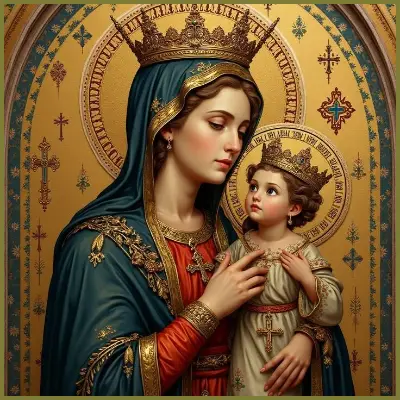
In Psalm 110:2, the phrase “The LORD sends out from Zion your mighty sceptre, Rule in the midst of your foes” can be seen as a powerful proclamation of authority and kingship. When we interpret this verse in the context of the Virgin Mary as the Queen Mother (Gebirah), it assumes a profound significance that reflects her role in the divine plan and her intercessory power. Zion, often symbolizing the city of God or the spiritual realm, is where God’s presence dwells and where His reign is established. By sending out a “mighty sceptre,” this verse signifies the authority and dominion vested in a king. In Christian theology, Jesus is recognized as the King, and Mary, as His mother, holds a unique and exalted position as the Queen Mother.
In ancient Judea, from the time of King Solomon, the Queen Mother played a crucial role in the royal court, often acting as an advisor and intermediary. Similarly, Mary, as the Mother of Jesus, is seen as a significant figure who intercedes on behalf of humanity. Her acceptance of God’s will and her role in salvation history exemplify her as a source of strength and guidance. Moreover, the latter part of the verse, “Rule in the midst of your foes,” can be related to the spiritual battle that Christians believe exists between good and evil. In Catholic tradition, Mary is often depicted as a warrior against sin and evil, embodying the qualities of strength and resilience. As the Queen Mother, she is invoked for her powerful intercession against spiritual foes, providing comfort and protection to those who seek her help (Rev 12:17).
In essence, this verse can be understood as a recognition of Mary’s profound influence and authority as the Queen Mother. She is not just the mother of a king but a vital participant in God’s plan, ruling alongside her son and offering her maternal care and support to the faithful. Her role transcends mere motherhood, establishing her as a figure of spiritual authority and solace, deeply connected to the victory of Christ our King over evil. Psalm 110:2 encapsulates a vision of divine authority and kingship while also inviting us to reflect on the broader themes of hope found in both the imagery of Daughter Zion and the role of Mary in the New Testament. The interplay between these elements highlights the continuity of God’s promises from the Old to the New Testament and the fulfillment of these hopes in the person of Jesus Christ.

What can I say for you, to what compare you,
O daughter Jerusalem?
To what can I liken you, that I may comfort you,
O virgin daughter Zion?
For vast as the sea is your ruin; who can heal you?
Lamentations 2, 13
Lamentations 2:13 is a poignant reflection on the devastation experienced by Jerusalem following its destruction, particularly during the Babylonian Siege in 586 BCE. In its historical context, “daughter Jerusalem” and “virgin daughter Zion” are poetic personifications of the city of Jerusalem and its inhabitants. The use of these terms conveys a deep sense of loss, vulnerability, and mourning. The metaphor of a daughter evokes notions of innocence, purity, and attachment, suggesting that the city, like a beloved daughter, has suffered tremendous harm and betrayal.
The phrase “vast as the sea is your ruin” illustrates the overwhelming nature of the destruction that befell Jerusalem. This destruction included not only physical devastation but also spiritual and communal disintegration. The reference to the sea, often seen as chaotic and uncontrollable, emphasizes the depth of sorrow and hopelessness in the face of such a tragedy.

In lamenting Jerusalem’s fate, the text raises profound questions about healing and restoration. The rhetorical question, “Who can heal you?” underscores a sense of despair that suggests there may be no remedy for such extensive loss. It reflects the collective grief of the people, who are left to grapple with the consequences of their actions and the perceived abandonment by God.
In the broader context of Jewish history, this lamentation serves as a reminder of the dire consequences of sin and disobedience, which, according to the biblical narrative, led to the city’s downfall. It also sets the stage for later themes of hope and redemption in both the prophetic literature and the continuing Jewish faith. The idea that despite such ruin, the possibility of restoration resonates deeply in Jewish thought.

The text from Lamentations 2:13 uses vivid imagery to express the profound sorrow and devastation experienced by Jerusalem, personifying the city as a grieving daughter. When we connect this lamentation with the figure of the Virgin Mary, particularly in her role as Our Lady of Sorrows, a rich and significant parallel emerges.
In this context, the “daughter Jerusalem” can be interpreted as a prophetic embodiment of Mary, who stands not only as a representative of the faithful people of God but also reflects the deep sorrow and suffering associated with witnessing the crucifixion of her son, Jesus Christ. Just as the lament addresses the vastness of Jerusalem’s ruin, Mary’s sorrow encompasses the immense grief of losing her child, who was also her Savior. The imagery of her being likened to the “virgin daughter Zion” emphasizes her purity and unique role in salvation history, as she bears the weight of her sorrows with unwavering faith.

The phrase “who can heal you?” resonates deeply with Mary’s maternal suffering. While the lament speaks to the hopelessness of the people in Jerusalem, Mary’s sorrow ultimately leads to a source of healing for humanity. Through her acceptance and participation in the suffering of Christ, she becomes a mediator of grace and comfort in the midst of pain and loss. Mary’s title “Our Lady of Sorrows” reflects this dual experience of profound grief and hopeful intercession.
Furthermore, the text evokes the idea that the depth of suffering, much like the vast sea referenced in the lamentation, is overwhelming yet not without the possibility of redemption. Mary’s suffering, while immense, is also transformative, as it leads not only to her own spiritual growth but also to the hope of resurrection and renewal for all believers. By examining this connection, we gain a deeper appreciation for Mary as a figure of strength in sorrow, embodying the pain of her people while also standing in a place of intercession, guiding the faithful through their own trials, much like the city that is deeply mourned.
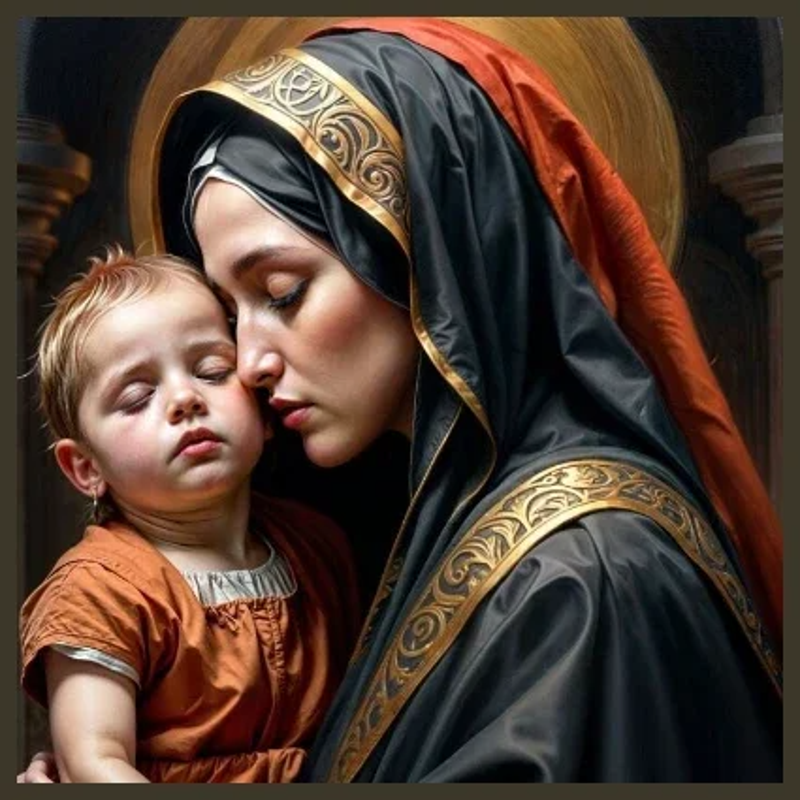
Now, why art thou drawn together with grief?
Hast thou no king in thee, or is thy counsellor perished,
because sorrow hath taken thee as a woman in labour.
Micah 4, 9
The text evokes a deep sense of lamentation and questioning regarding grief and loss. When we connect this passage to the figure of Daughter Zion and the Virgin Mary at the foot of the cross, a rich tapestry of meaning emerges.
Daughter Zion is often personified in biblical literature as a representation of Jerusalem and, more broadly, the people of Israel. In a state of mourning, Daughter Zion questions why she finds herself overwhelmed by sorrow, paralleling the pain of childbirth. This image evokes the turmoil and trauma of exile and suffering. This lament can symbolize the collective grief of a people who have lost their way, their king, or their divine guidance. It indicates a deep yearning for restoration and the presence of leadership in times of distress. The Virgin Mary, on the other hand, as she stands at the foot of the cross, embodies the archetype of suffering that connects to the church and humanity. Her grief is profound as she witnesses the crucifixion of her son, Jesus Christ. In this moment, Mary’s pain is akin to that of Daughter Zion; both figures experience the weight of sorrow—Mary as a mother losing her child, and Daughter Zion as a nation witnessing the loss of hope and divine promise with the loss of the Davidic monarchy. Both figures also highlight themes of endurance in the face of suffering and the transformative power of grief. While mourning, they connect with a broader narrative of redemption. For Daughter Zion, there is a hope for restoration, and for Mary, her experience of loss is intertwined with the potential for new life through resurrection.
Overall, the text resonates with the sorrowful experiences of both Daughter Zion and the Virgin Mary, linking their grief to a deeper understanding of loss, hope, and the resilience found in both personal and communal struggles. Through their stories, we are invited to reflect on the nature of suffering and the promise of renewal that can emerge from it.

For I heard a cry as of a woman in labor,
anguish as of one bringing forth her first child,
the cry of daughter Zion gasping for breath,
stretching out her hands,
“Woe is me! I am fainting before killers!”
Jeremiah 4, 31
The verse from Jeremiah 4:31 expresses a profound sense of anguish and despair, personified through the imagery of a woman in labor. In its historical context, this passage is situated during a tumultuous period for the people of Israel. The prophet Jeremiah is addressing the impending destruction of Jerusalem and the suffering that will result from the Babylonian invasion. The pain and cries of “daughter Zion” symbolize the collective grief of the nation, personifying Jerusalem as a mother in distress.
“Daughter Zion” represents not only the geographical city but also the cultural and spiritual heart of the Jewish people. In biblical literature, Zion is often depicted as a woman, embodying the relationship between God and His chosen people. The cry of “Woe is me! I am fainting before killers!” highlights the deep sense of helplessness and vulnerability experienced by the people as they face destruction. This lamentation reflects a deep emotional and spiritual crisis as society grapples with the consequences of its infidelity to God.

Connecting Jeremiah 4:31 to the figure of Mary as co-Redemptrix adds significant depth to our understanding, particularly within the context of Catholic theology. In this framework, Mary, the mother of Jesus, is often viewed as a co-redeeming figure due to her unwavering acceptance of God’s divine will and her vital role in the overarching salvation narrative. Just as “daughter Zion” personifies the collective suffering and deep longing for redemption experienced by the nation of Israel, Mary endures profound personal suffering and anguish during the Passion and crucifixion of Christ. Her heartache reflects the depth of her maternal love—she stands at the foot of the cross, witnessing her Son’s torment and sacrificial death. This active participation in her Son’s redemptive mission embodies the essence of her unique role in salvation history.
Mary’s sufferings can also be understood in light of Simeon’s prophecy in Luke 2:35, where he foretells that a sword will pierce her soul. This metaphorical sword symbolizes the intense trials and emotional pains she encounters as she consents to God’s plan, making her an integral partner in the new covenant. Through her willingness to accept her role, Mary exemplifies a model of discipleship, demonstrating profound faith and trust in God’s salvific plan for humanity. Thus, the connection between Jeremiah 4:31 and Mary as co-Redemptrix enriches our comprehension of suffering and redemption, illustrating how both figures bear witness to the profound mystery of divine grace interwoven with the human experience.
Both figures—daughter Zion and Mary—reflect themes of suffering, redemption, and renewal. In their narratives, the anguish of labor symbolizes the suffering that precedes the birth of new life. For Zion, it is the distress of a nation facing destruction, while for Mary, it is the bearing of the Messiah, who will ultimately bring salvation. By exploring these connections, we can see how the themes of grief and hope intertwine within the broader biblical narrative, offering insights into the complexities of faith, motherhood, and redemption.
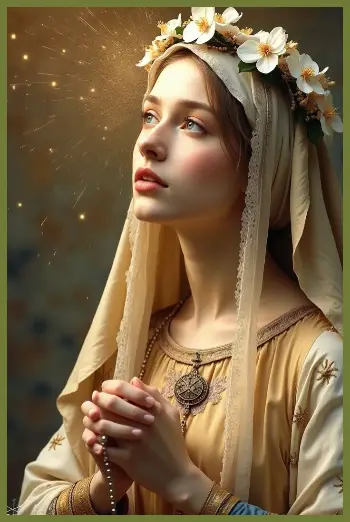
Your sun will never set again,
and your moon will wane no more;
the LORD will be your everlasting light,
and your days of sorrow will end.
Then all your people will be righteous
and they will possess the land forever.
They are the shoot I have planted,
the work of my hands,
for the display of my splendor.
Isaiah 60, 20-21
Isaiah 60:20-21 is part of a prophetic vision concerning the restoration of Israel and the glorious future that awaits God’s people. This passage emphasizes a transformative divine intervention where sorrow and darkness will be replaced by everlasting light and righteousness.
In its immediate context, Isaiah 60 is situated within a section that speaks to the restoration and future glory of Zion (Jerusalem) after a period of exile and suffering. The imagery of the sun and moon here signifies an end to cycles of darkness and despair; it reflects a time when God’s presence will illuminate the lives of His people permanently. The promise of righteousness suggests that the citizens of Zion will embody justice and goodness, reflecting God’s character. The reference to people as “the shoots I have planted” indicates God’s active role in nurturing His people, emphasizing that they are not just restored but purposefully cultivated for His glory. The restoration of Zion is a recurring theme in Isaiah, which presents Zion as a symbol of hope, divine favor, and the ultimate realization of God’s kingdom on Earth.

“Daughter Zion” is often used to personify Jerusalem as a female figure, representing the city itself and its people. In biblical literature, the imagery of Daughter Zion expresses both the pain of exile and the joy of restoration. This text can be interpreted as a prophetic promise to Daughter Zion that her mourning will end and her glory will be restored, thereby reinforcing her identity as the dwelling place of God’s presence.
Linking this text to Mary, we can perceive her as the New Zion, symbolizing the culmination of God’s covenant promise to His people. In Christian theology, Mary is recognized as the ultimate fulfillment of the biblical promise of a righteous remnant, as she willingly accepts her monumental role in bearing Jesus, the Messiah, who is revered as the ultimate light of the world. The themes of light and righteousness, as eloquently portrayed in the Book of Isaiah, resonate profoundly with Mary’s narrative, particularly at the moment of the Annunciation. During this pivotal encounter, the angel Gabriel conveys God’s divine plan, and Mary responds with unwavering faith and a spirit of obedience, exemplifying her remarkable trust in God’s will. Her acceptance not only highlights her role in salvation history but also emphasizes her embodiment of hope for a world in darkness, ultimately illustrating the transformative power of responding to God’s call.
In this sense, Mary represents the culmination of God’s promise to His people, ushering in a new era marked by the presence of Jesus, who brings both physical and spiritual light to the world. Just as Isaiah foretold a time when sorrow would cease, Mary’s acceptance reflects the beginning of a new hope, aligning with the themes of restoration and divine favor that Isaiah proclaims for Daughter Zion. Thus, the text serves as an essential link between the promise of restoration for Zion and its fulfillment through Mary, highlighting the continuity of God’s redemptive plan from the Old Testament to the New Testament.
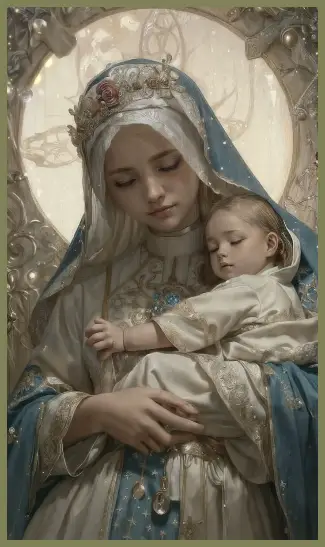
GIVE praise, O thou barren,
that bearest not: sing forth praise,
and make a joyful noise,
thou that didst not travail with child:
for many are the children of the desolate,
more than of her that hath a husband,
saith the Lord.
Isaiah 54, 1
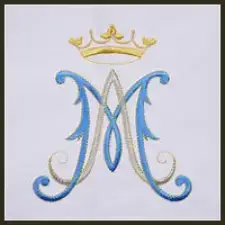
AVE MARIA
Create Your Own Website With Webador